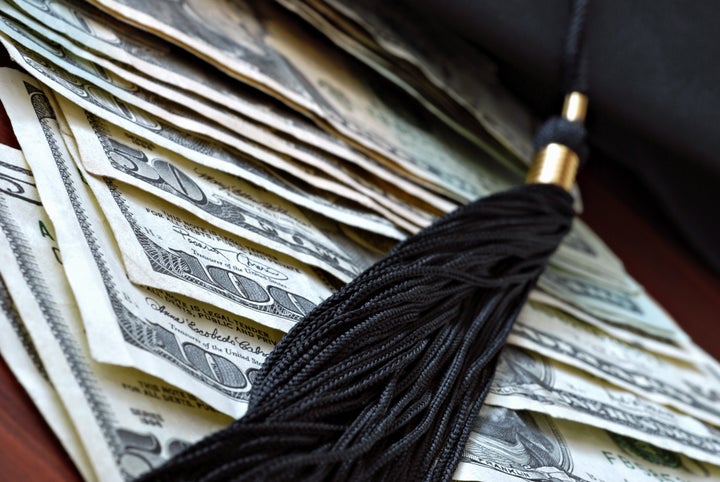
A college president once quipped that higher education is one of the few things that a person is willing to pay for but not receive. Another wise observer noted that college is the rare case where the customer tries to get as little as he can for the money.
Given the jagged economic landscape, given the massive restructuring of the global economy, given the delayed retirement of the current workforce and given the lack of high-paying entry level jobs for college graduates, those jokes are no longer a laughing matter for many critics. America's colleges and universities are on the defensive, typified by a Newsweek cover story asking, "Is College a Lousy Investment?"
Newseek writer Megan McArdle argues that a higher-education bubble is about to burst, just as tech bubbles and housing bubbles burst, and that devastating chaos will result.
The article and accompanying visuals offer horror stories of students in six-figure debt. Other news coverage has reported that Americans may carry $900 billion in student loan debt.
Critics contend that college cannot last in its current form. But a reality check may be in order.
First, consider the overall returns. As Daniel Luzer of the Washington Monthly writes in a rebuttal to McArdle, college graduates make 84 percent more over a lifetime than high school graduates, and do have considerably better job prospects even during a severe downturn such as this one. Yes, nearly 20 percent of college graduates were "under-employed" in the past year. But the figure for those lacking a college degree was an eye-popping 56 percent.
Next, consider the actual burden faced by graduates. Some reports estimate that the average debt burden is about $23,000 (this includes federal and non-federal loans and loans for undergraduate, graduate and professional degrees). Yet a report by the Association of American Universities, the 62-member consortium of North America's best research universities, found that the median balance is closer to $13,000, which suggests that "the average is being pushed higher by a relatively small number of borrowers with very high loan balances."
Digging deeper, the AAU finds that nearly 40 percent of recent public-university students and 30 percent of recent private-university students graduated with no debt. Among those who did take on debt, 43 percent owe less than $10,000 and 72 percent owe less than $25,000. Only 3 percent of borrowers owe the six-figure amounts that Newsweek dwells on. (Granted, those are massive amounts, especially in a recession. Anyone who considers taking on such debt should do so very carefully, should consider other options, and hopefully should not do so to pay for a graduate degree in an obscure and low-paying field.)
But is there a "college bubble" about to burst? Most skeptics of higher education have waited (and perhaps panted) for some combination of the Internet and for-profit enterprises to do a little "creative destruction" of America's ivy-covered campuses. The invisible hand of the free market would democratize education, they have said, stripping it down to its low-cost essentials.
No such luck. While 28 percent of student borrowers at traditional non-profit institutions owe more than $25,000, a whopping 67 percent of borrowers at for-profit institutions owe more than that amount.
Is traditional, nonprofit college still an investment that won't crush most investors? In 2009, during the depths of the downturn, the government-backed student loan default rate for graduates of traditional colleges was nearly 5 percent. But the default rate for graduates of for-profit colleges was more than 15 percent.
A fascinating statistic emerges: For AAU universities -- top institutions such as Yale and Harvard in the northeast; USC, UCLA, UC Berkeley, Stanford and Caltech in the West; and the Universities of Michigan and Texas in the midsection -- the default rate was only 2.2 percent for that same period. While AAU universities have been questioned for their ability to balance teaching and research, something in the water is allowing them to produce people who succeed even in difficult times.
(In fact, while the share of students graduating with no government-backed loan debt stayed roughly the same between 2003 and 2010, that figure actually declined at AAU universities.)
College is not inexpensive, and for-profit and online institutions have not been able to change this (even while they offer an inferior product in terms of academic, social and extracurricular offerings). Perhaps college was not meant to be a bargain, not meant to be distilled to economic bottom lines.
Traditional college still represents a premier societal aspiration, one that has evolved through the full engagement of the free market's invisible hand. Parents demand not just top programs for their children, but also outstanding dormitories and dining halls and technology infrastructure. Proud alumni give tens of millions of dollars to fund such facilities. The federal government funds university-based research that has given the United States preeminence within global revolutions in electronics, communications, personal computing and the Internet (and soon, a biomedical revolution).
It should be noted that Newsweek covered this ground 36 years ago in a similar cover story asking "Who Needs College?" Newsweek claimed then that colleges could not survive the brutal realities of hordes of Ph.D. graduates driving taxis.
There may be many reasons for the current economic malaise. Too much education is not one of them.